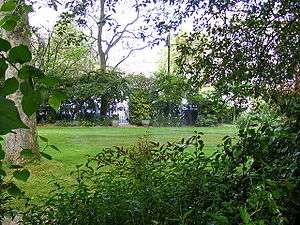Wilton Crescent


Wilton Crescent is a street in Belgravia, London.
Overview
Wilton Crescent was created by Thomas Cundy II, the Grosvenor family estate surveyor, and was drawn up with the original 1821 Wyatt plan for Belgravia.[1] It was named at the time of Thomas Egerton, 2nd Earl of Wilton, second son of Robert Grosvenor, 1st Marquess of Westminster on whose estate the road was built in 1825 by Seth Smith.
In the 19th and 20th century, it was home to many prominent British politicians, ambassadors and civil servants. Louis Mountbatten, 1st Earl Mountbatten of Burma (1900–1979) lived at 2 Wilton Crescent for many years. Today there is a blue plaque on the house marking this. Like much of Belgravia, Wilton Crescent is characterised by grand terraces with lavish white houses which are built in a crescent shape, many of them with stuccoed balconies, particularly on the southern part of the crescent. The houses to the north of the crescent are stone clad and five stories high and were refaced between 1908 and 1912. Most of the houses had originally been built in the stucco style, but such houses became stone clad during this renovation period. Other houses today have black iron balconies.
Wilton Crescent lies east of Lowndes Square and Lowndes Street, to the northwest of Belgrave Square. It is accessed via Wilton Place which connects it to the main road in Knightsbridge. It is adjacent to Grosvenor Crescent to the east, which contains the Indonesian Embassy. Further to the east lies Buckingham Palace. The play Major Barbara is partly set at Lady Britomart's house in Wilton Crescent. In 2007, Wilton Garden in the middle of the crescent won a bronze medal by the London Gardens Society.
There are two diplomatic buildings in Wilton Crescent: the High Commission of Singapore at No. 9,[2] and the Embassy of Luxembourg at No. 27 (formerly home to the Luxembourgish government-in-exile).[3][4]
Notable residents
- Edward Pleydell-Bouverie (1818–1889); 44 Wilton Crescent
- Louis Mountbatten, 1st Earl Mountbatten of Burma (1900–1979); 2 Wilton Crescent
- Sir Percy Loraine, 12th Baronet (1880–1961); 19 Wilton Crescent
- Earls of Kinnoull, 41 Wilton Crescent[5]
- George Rennie (engineer) (1791–1866); 39 Wilton Crescent
- Alfonso López Pumarejo (twice president of Colombia); 33 Wilton Crescent
- Sir Edmund Vivian Gabriel (1875-1950); 41 Wilton Crescent
- Quentin Crewe (1926-1998), writer
- Edmund Phipps (1808-1857), lawyer and writer
- Spencer Ponsonby-Fane (1824-1915)
- Elizabeth Bertie-Mathew, philanthropist
- Honourable Edmund Knox (1787-1867), Royal Navy Admiral
- HRH Grand Duchess Charlotte of Luxembourg (1896-1985); stayed on various occasion at 27 Wilton Crescent (now the Luxembourg Embassy) while in exile in London during World War II.
See also
References
- ↑ Opensquares.org
- ↑ "The London Diplomatic List" (PDF). 14 December 2013.
- ↑ "Luxembourg Embassy In London". allinlondon.co.uk. Retrieved 6 May 2013.
- ↑ "The London Diplomatic List" (PDF). 14 December 2013.
- ↑ A Genealogical and Heraldic Dictionary of the Peerage and Baronetage of the British Empire. 42. Henry Colburn. 1880. p. 710.
External links
| Wikimedia Commons has media related to Wilton Crescent. |
Coordinates: 51°30′02″N 0°09′20″W / 51.50056°N 0.15556°W
